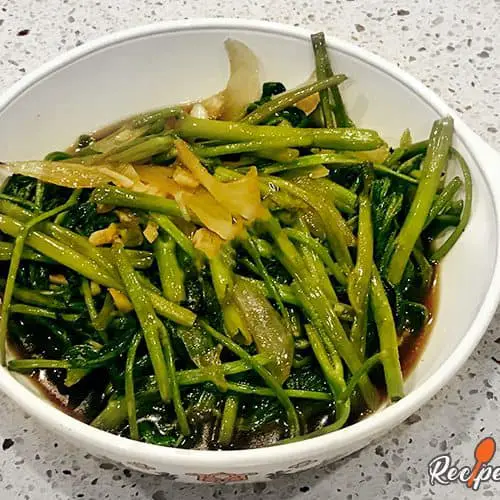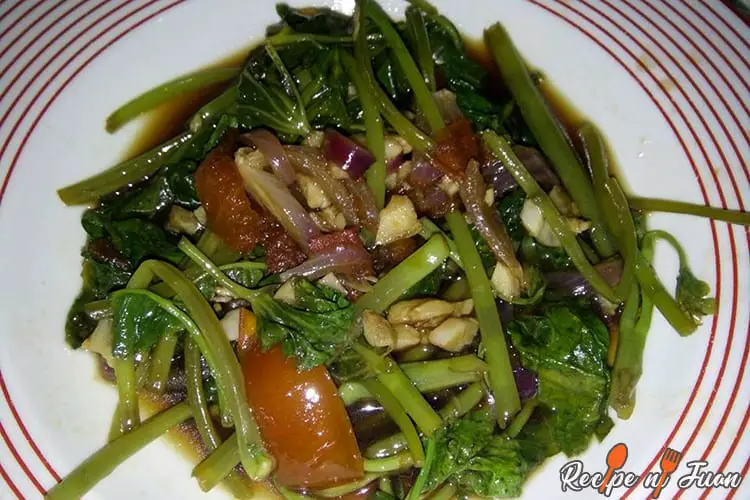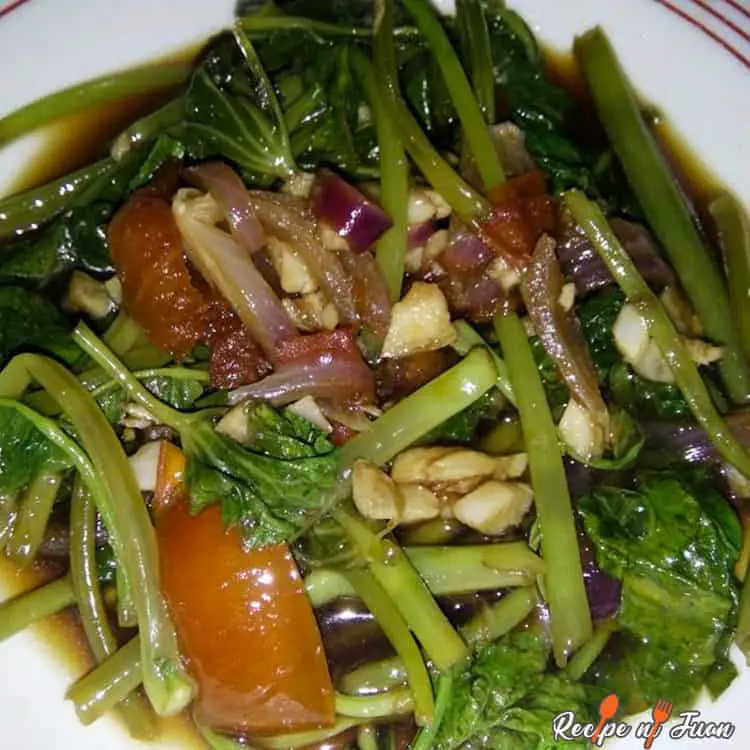Easy way to cook adobong kangkong: Recipe with water spinach
Do you know what the beauty of excellent cuisine is? It has every sort of food. From expensive delicacies to after-work dishes and anything in between, there’s something for everyone to give their tastebuds an embrace of deliciousness!
One of those cuisines is the Filipino one. In my series of blog posts dedicated to Filipino cuisine, this time, I’ll be discussing adobong kangkong, an ordinary man’s dish made of water spinach that’s accessible, affordable, and simply mouthwatering!
The article will include everything you need to know about the “poor man’s dish” and all the fantastic variations you can make out of it by tweaking the original ingredients. Plus, a recipe to try out on your next weekend.
So let’s get into it!


Check out our new cookbook
Bitemybun's family recipes with complete meal planner and recipe guide.
Try it out for free with Kindle Unlimited:
Read for freeIn this post we'll cover:
Adobong kangkong recipe
Ingredients
- 1 to 2 bundles kangkong (water spinach) cut into 2-inch pieces
- 2 tbsp oil
- 4 cloves garlic minced
- 1 tbsp APF (all-purpose flour)
- Water (or broth)
- 2 tbsp soy sauce
- 2 tbsp vinegar
- Pepper
- Salt to taste
Instructions
- Heat oil in a wok (or a large frying pan). Sauté garlic until the color is golden brown. Remove the garlic from the wok and put it into a separate bowl.
- Add chopped onions to the wok and sauté until soft.
- Add soy sauce, vinegar, and pepper. Bring to a boil.
- Add kangkong (water spinach). Cook just until wilted, or for 1 minute maximum. Adjust soy sauce according to your taste, if needed.
- Season it with salt and pepper to taste and top it with sauteed garlic.
- Remove from heat and serve!
Watch this quick video by YouTube user Mangtan Tayo TV on how to make adobong kangkong:
Cooking tips
Although the traditional recipe of adobong kangkong only makes use of water spinach as a primary ingredient, you could also add a little pork to the recipe to quench your craving for proteins.
To add adobo to your adobong kangkong recipe, you’ll just need to take one extra step. Add pork belly chunks and a little water or broth to the wok after you’ve sautéd the onions.
Afterward, the whole cooking process is just the same. The addition of pork will give your recipe that much-needed touch of fatty sweetness to enhance the dish’s flavor, and make it a perfectly healthy dish for protein savvies.
If you don’t have pork available at home, you could also make use of some chicken breasts. Though they won’t add that fatty goodness to the dish, the natural taste of chicken is something you just can’t dislike!
If you have some leftover cabbage, you can make this amazing Pinoy pesang manok.

Substitutes and variations for adobong kangkong
Thanks to the rather liberal approach of Filipinos toward their food, almost every dish they make has variations you can try out to find out which ones appeal to your tastebuds the most.
Adobo is no exception! Just like the vegetarians’ favorite adobong kangkong, there are also 3 other variations of the dish you can try out.
Pork adobo
Nothing tastes bad when there are succulent chunks of pork in it.
Pork adobo uses a pig’s fattiest part: the legendary pork belly. It’s one of the most common takes on the Filipino classic and one of my personal favorites.
However, as apparent, it’s a bit heavy on protein and fats, so there’s a chance it might not be for you. ;)
Chicken adobo
Chicken adobo is another foodie favorite and is as popular among people as pork adobo. As can be predicted from the name, it uses chicken instead of pork.
However, what makes it unique is the 2 different ways you can make it; namely, dry and wet. The dish’s texture depends on how many ingredients you add, and most importantly, the sauce you use.
I like to make the dry version of the dish because that way, every ingredient absorbs an ample amount of sauce, giving out a very defined, unique, and delicious taste and aroma.
Fish adobo/adobong pusit
Ok, this one might be people’s least favorite when it comes to making adobong, but guess what: some foodies still love it, especially those with a penchant for seafood!
The dish tastes a bit different than the varieties mentioned above, having subtle notes of umami flavor. Plus, it’s always served with rice.
Though not as common, it’s still a thing to kill your appetite for seafood, with a unique touch.
How to serve and eat adobong kangkong
Adobong kangkong is traditionally served on a plate and topped with roasted garlic and fresh cilantro leaves.
You can also present it as a side dish with rice or a meat dish of your choice. However, rice is preferable, as it absorbs all the sauces while also highlighting the explosive flavors of the dish.

Once fully prepared and dressed, serve it to your guests. They’ll love it!
Similar dishes
If you enjoy eating adobong kangkong or vegetarian dishes in general, the following are more delicious dishes from the Filipino cuisine you’d maybe like to try for yourself.
Spinach laing
Originally made from gabi leaves, laing can also be made from spinach leaves and will taste as good. Other ingredients of this dish include ginger, coconut milk, and hot chili peppers.
The dish generally has a very creamy texture and spicy taste. It’s usually served with steamed rice.
Vegan Bicol Express
Bicol Express is a creamy, spicy, and wholesome dish with tofu, green beans, and coconut as its primary ingredients. It’s a delicious variant of the traditional Filipino staple that includes pork and is excellent for a vegan’s tastebuds.
It’s usually eaten as a main course.
Pinakbet
Pinakbet is a pretty common vegetable stew sold all around the Philippines. Its primary ingredients include eggplant, tomatoes, string beans, and okra, all sauteed in shrimp or fish sauce.
The dish has many versions across the country and is available in protein (pork) and non-protein varieties. Make the recipe that suits you best.
FAQs
Can I use oyster sauce in adobong kangkong?
Yes, you can! Oyster sauce is quite a common substitute for soy sauce in most dishes.
However, it’s generally sweeter and thicker than soy sauce, with less saltiness. So you should add it with a pinch of salt to neutralize its otherwise sweet flavor.
Is adobong kangkong healthy?
Kangkong leaves are an excellent source of vitamin A, significantly improving vision and boosting the immune system. Moreover, it’s filled with iron, an essential component of blood. And when mixed with meat, it also becomes a good source of protein.
The antioxidants found in it also help improve your skin and hair health.
Can people with high cholesterol consume adobong kangkong?
Yes, they can! However, they should avoid adding pork belly to the dish, as it’s incredibly fatty.
Besides that, adobong kangkong has anti-cholesterol effects that benefit your health.
Can diabetics eat adobong kangkong?
Yes! Kangkong belongs to the spinach category; generally, it has a low glycemic index.
Since foods with low glycemic index have little to no effect on blood sugar levels, and adobong kangkong contains no sugar in its ingredients, the food is perfectly safe for people with diabetes.
Cook up this veggie dish today
Adobo is a Filpino staple that’s given birth to a bunch of daughter dishes that are all equally delicious. However, since all of those use meat in some form, adobong kangkong is generally a preferable option if you’re a vegetarian or if you simply want a comfort dish that’s easy to make and doesn’t cost much!
See you with another one. And good luck! ;)
Check out our new cookbook
Bitemybun's family recipes with complete meal planner and recipe guide.
Try it out for free with Kindle Unlimited:
Read for freeJoost Nusselder, the founder of Bite My Bun is a content marketer, dad and loves trying out new food with Japanese food at the heart of his passion, and together with his team he's been creating in-depth blog articles since 2016 to help loyal readers with recipes and cooking tips.
